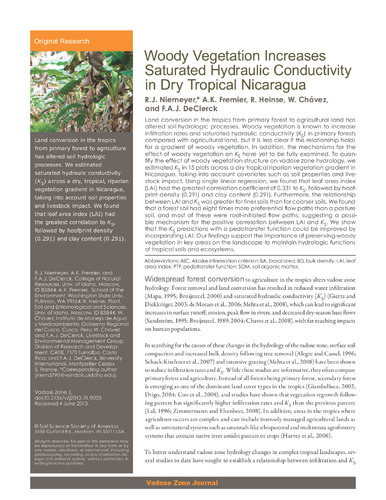Woody vegetation increases saturated hydraulic conductivity in dry tropical Nicaragua
Land conversion in the tropics from primary forest to agricultural land has altered soil hydrologic processes. Woody vegetation is known to increase infiltration rates and saturated hydraulic conductivity (KS) in primary forests compared with agricultural land, but it is less clear if this relationship holds for a gradient of woody vegetation. In addition, the mechanisms for the effect of woody vegetation on KS have yet to be fully examined. To quantify the effect of woody vegetation structure on vadose zone hydrology, we estimated KS in 15 plots across a dry tropical riparian vegetation gradient in Nicaragua, taking into account covariates such as soil properties and livestock impact. Using single linear regression, we found that leaf area index (LAI) had the greatest correlation coefficient of 0.331 to KS, followed by hoofprint density (0.291) and clay content (0.291). Furthermore, the relationship between LAI and KS was greater for finer soils than for coarser soils. We found that a forest soil had eight times more preferential flow paths than a pasture soil, and most of these were root‐initiated flow paths, suggesting a possible mechanism for the positive correlation between LAI and KS. We show that the KS predictions with a pedotransfer function could be improved by incorporating LAI. Our findings support the importance of preserving woody vegetation in key areas on the landscape to maintain hydrologic functions of tropical soils and ecosystems.

